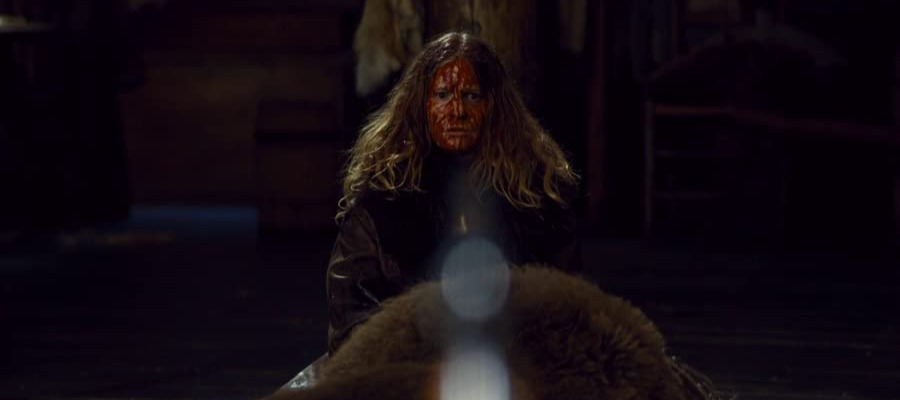‘The Hateful Eight’ is a Quentin Tarantino western mystery movie featuring Samuel L. Jackson, Jennifer Jason Leigh, and Kurt Russell. The film revolves around eight nefarious characters that find themselves having to wait out a blizzard in each other’s unpleasant company under the shelter of the same cabin. The cast of characters includes a myriad of personalities like bounty hunters Major Marquis Warren and John Ruth, former Confederate members Chris Mannix and Sanford Smithers, alongside others.
The movie takes place a few years after the Civil War in America and heavily delves into the socio-political environment of the time. Due to the setting and certain references to true historical events and people, viewers might wonder if the story and characters depicted in ‘The Hateful Eight’ are based on real life. Here is everything we know about ‘The Hateful Eight’ and its relationship to reality.
Tarantino’s Creative Commentary on Racism
No, ‘The Hateful Eight’ is not a true story. The film utilizes its socially fraught post-civil-war setting to explore the nuances of racism in America. Still, it maintains an intentional ambiguity when it comes to the story’s exact position in history. According to Tarantino, in the script, he wrote that the story takes place anywhere between 6-10 years after the Civil War. Though ‘The Hateful Eight’ serves as a commentary on the Civil War and its effects, it didn’t originally start out with that intention in mind.

Western shows like ‘Bonanza’ and ‘The Virginian’ were Tarantino’s inspiration behind ‘The Hateful Eight.’ Such shows often had one-off morally cryptic characters with an air of mystery around them and a dark, agitating past behind them. When Tarantino decided to make ‘The Hateful Eight,’ he essentially wanted to create a story full of characters like those. “All mysterious. All nefarious. You can’t quite trust anything they say, per se. You have to watch the whole thing to find out what’s going on. But there’s no hero. There’s no moral center,” he said on The Howard Stern Show while discussing the film’s origin.
While all characters are just products of Tarantino’s imagination in his quest to explore the depths of moral ambiguity, some characters may have similarities to historical figures. For instance, Walton Goggins’ character, Chris Mannix, is introduced as a rebel renegade whose father, Erskine, led the Mannix Maruaders at the time of the war. This detail is directly inspired by the real-life Confederate supporters, Quantrill’s Raiders.
“I felt that by throwing a black cavalry officer in the middle of this mix and knowing that I was going to have a Southern general and, like, the son of Quantrill in this mix, that I’d be kicking a can that deals with these [racial] issues,” said Tarantino in a conversation with Entertainment Weekly. Therefore, the film is intentionally inspired by the real-life political landscape of its time when discussing racism and depicting the dynamic between characters like Warren and Confederate supporters Mannix and Smithers.
Similarly, other historic characteristics like the Battle of Baton Rouge are also used as plot points to provide backstories for characters like Warren and Smithers. In the film, the two fought on the battlefield from opposite sides, and their hostility towards one another ultimately acts as a tool to move along the plot of the movie. While the storyline adds a lot to the characters and the tense atmosphere of the film, it also contradicts history as it actually stands.
In the real Battle Rouge, African-Americans never actually fought on the battlefield as soldiers. Therefore, in reality, it would be near-impossible for an individual to exist with Warren’s backstory. However, it is important to remember that Tarantino often changes things up in terms of historical accuracy when it comes to telling stories. Ultimately there is no tangible connection between the events depicted in ‘The Hateful Eight’ and real life, other than the few historical references made in the film.
‘The Hateful Eight’ is laced with classic Western nostalgia with its outlaw, cowboy, and bounty hunter characters. On the other hand, unlike most Westerns, it massively focuses on the racist social environment of its era. As such, it examines the ramifications and outcomes of the Civil War through its plot. Additionally, the film focuses on a darker part of the human psyche by presenting the audience with exclusively morally ambiguous, villainous characters. Though the movie is not based on a true story, it offers a bleak but still raw portrayal of the human condition.
Read More: Best Western Movies of All Time

You must be logged in to post a comment.